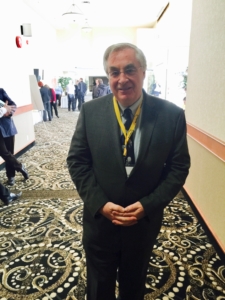Optimism radiated from the hog industry recently for two days in Winnipeg, MB as part of the Manitoba Swine Seminar.
That is despite some ominous clouds on the horizon involving trade deals and hog prices lower than anticipated because of the United States hog industry increasing production dramatically.
“Prices seem to be holding but profits in the U.S. will be slim in 2017,” said Andrew Dickson, general manager of Manitoba Pork. “But because of the Canadian exchange rate, our producers should be able to break even, and in some cases might even make some money, depending on how they price their inputs and how they price their pig sales when they sell it off the farm.”
Dickson in his statement of the hog industry to kick off the MSS, says this year as it always should be, will be very critical how hog producers tend to both ends of their business, inputs, and sales, and of course management from sow to finish, depending at when they sell their pigs.
 In an interview, he says producers must make sure they have a margin in there so they can service the fixed costs, which is about 93 per cent of the pig.
In an interview, he says producers must make sure they have a margin in there so they can service the fixed costs, which is about 93 per cent of the pig.
“The good news is that by the end of 2017 or early 2018 there is new a processing capacity coming into play in the U.S., and hopefully that will peel off some of the pressure that is on the existing processing capacity and increasing demand from producers.
“The thing we have to worry about is pork exports because if you want the price in the North American market to go up, you have to get the pork out of North America and that will pull up the U.S. domestic price,” said Dickson. “Exports are critical because of the U.S. exports 25 to 30 per cent of their production. There are some unknowns about the American dollar going up or down relative to the other currencies.”
He says, more importantly, tearing up the Trans-Pacific Partnership was not good news for the pig business.
“It was going to open up markets for Canadians and Americans in profitable markets like Japan, Vietnam and so on,” said the MPC GM. “Then this discussion about NAFTA and maybe having to renegotiate NAFTA is very worrisome for us both in Canada and the U.S. It has been good for the two industries. Both industries have grown, in fact, trade has been so good where the Americans have captured something like 20 to 25 per cent of our domestic market at the same time we may have capture three, four, or five per cent of their domestic market — of course, their market is ten times bigger than ours.”
Dickson says NAFTA is good for the industries on both sides of the border. They have cuts Canada is short of, and Canada has cuts that they may be short of.
On the other hand, Premier Brian Pallister’s new government has provided a new atmosphere where they want to see the industry grow, to see more barns built, produce more pigs to fill up the processing plants and what can they do to help.
The hog industry is happy to see government announce making changes to the Farm Building Code and moving away from this white commercial standard that the industry somehow got tied up in.
“To a more sensible Farm Building Code that we can maybe reduce some of the costs to replace the barn infrastructure, maybe five to 10 per cent but it is helpful. Every little bit helps,” he sayid. “We’re also looking at some changes to the Environment Act, getting rid of the anaerobic digester ideas and streamlining this municipal planning process, still allowing for public input to where the industry will place these barns, but at the same time a more rational approach to developments.”
Dickson says, in other words, permitting livestock development in areas zoned for livestock development.
“It can’t be a tossup every time as to whether they’ll permit a development or not. If you stand back and look at the industry over the next ten years, we need to replace all of our buildings because most are getting 18 to 19 years old. They were designed for a lifespan of 25 years,” he said. “At some point, we have to replace them and we’re looking at a $1.7 billion challenge.”
Dickson agrees it isn’t as simple as ripping up the moratorium the previous government legislated, it has some common sense planning going forward.
“You don’t amend legislation lightly, we’re encouraging the government to not do it piecemeal, but part of a bigger package so that it all makes sense,” he said. “They understand that as well, not wanting to go back opening up pieces of legislation every time you find something that doesn’t quite work.” •
— By Harry Siemens





